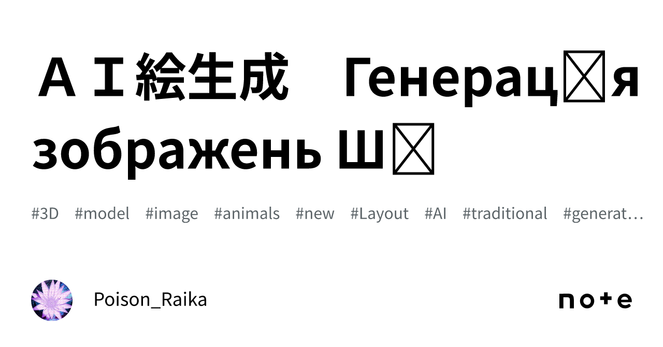AI絵生成 Генерація зображень ШІ
AI絵生成ソフトで何処が失敗してるかと云えば、人間の体の構造や比率を充分学習させてないと云う点が大きい。
Основна помилка програмного забезпечення для створення зображень ШІ полягає в тому,
https://note.com/poison_raika/n/n501ac31af2f1
<>

AI絵生成 Генерація зображень ШІ
AI絵生成ソフトで何処が失敗してるかと云えば、人間の体の構造や比率を充分学習させてないと云う点が大きい。
Основна помилка програмного забезпечення для створення зображень ШІ полягає в тому,
https://note.com/poison_raika/n/n501ac31af2f1
<>

14 Ways to Quickly Improve Your Photography fro, Digital Photography School [Shared]
Feeling like your photography skills have plateaued? It happens to the best of us. One minute, you’re cruising along, picking up new techniques and elevating your sense of composition and light like a boss – and the next, you’ve hit a creative wall.
But don’t worry! While there’s no single magic bullet for improving your photography, I do have plenty of techniques and exercises that are designed to help you level up your skills, and that’s what I share in this article.
Note that different techniques will work better for different shooters, so if you don’t like a method, just skip it and move on. With any luck, you’ll find an approach that works for you, and you’ll be able to develop that creative eye once again.
Establishing #Methods to #Monitor #Influenza A #H5N1 Virus in Dairy #Cattle #Milk, #Massachusetts, #USA, https://etidiohnew.blogspot.com/2025/03/establishing-methods-to-monitor.html
AI絵生成 Генерація зображень ШІ
AI絵生成ソフトで何処が失敗してるかと云えば、人間の体の構造や比率を充分学習させてないと云う点が大きい。
Основна помилка програмного забезпечення для створення зображень ШІ полягає в тому,
https://note.com/poison_raika/n/n501ac31af2f1
<>

"My methods are working and conceptual methods and therefore have spread everywhere." – Emmy Noether (1882-1935)
#quote #mathematics #maths #math #methods
AI絵生成 Генерація зображень ШІ
AI絵生成ソフトで何処が失敗してるかと云えば、人間の体の構造や比率を充分学習させてないと云う点が大きい。
Основна помилка програмного забезпечення для створення зображень ШІ полягає в тому,
https://note.com/poison_raika/n/n501ac31af2f1
<>

Here's a #Ruby #design #question that regularly pops up in various contexts such as this: The Mailjet gem is a REST API adapter, 99% generated code. It exposes things as #class #methods like `Mailjet::Contact.create`. For a simpler, more consistent interface, I'm wrapping these in my own #PORO service class, all class methods as well, but I don't like this orgy of `class << self`. How to better design this? Here's a gist with the method bodies removed for readability: https://gist.github.com/svoop/25accb41d09a667e54c98b6f04a21fdd

Quality Humor - Documents in a business are living and need to be updated as changes occur or if more efficient methods are found. #documents #processes #humor #quality #business #methods #change
and this paper also in MBMG erally nice : good work Tiina
https://mbmg.pensoft.net/article/130834/
Technology Readiness Level of biodiversity monitoring with molecular methods – where are we on the road to routine implementation?
by Laamanen et al.
#edna #methods #TRL #metabarcoding #standardisation
Nice paper in MBMG about eDNA methods standardisation
https://mbmg.pensoft.net/article/132076/
What is eDNA method standardisation and why do we need it? by Theroux et al.
#Environmental #DNA #lab #accreditation #management #methods #standardisation #edna
Gynepunk Lab zine!
by schoolofmachines
https://bit.ly/gynepunkLabZine
including brilliant and wonderful people and projects including @astrodesia @bioartcoven @doreentoutikian @omgyno_ @bruixes_lab @_almafutura_
GSPy - A New Toolbox And Data Standard For Geophysical Datasets
--
https://doi.org/10.3389/feart.2022.907614 <-- shared paper
--
https://doi.org/10.5066/P9XNQVGQ | https://code.usgs.gov/g3sc/gspy <-- shared code repository
--
[an older paper, but code is in active and ongoing development/evolution]
#GIS #spatial #mapping #geophysics #geophysical #NetCDF #datatypes #code #opensource #library #dataformats #standardisation #standardization #openstandard #portable #metadata #Python #package #GSPy #methods #workflows #xarray #CRS #opendata #architecture #toolbox
#review #microscopy #methods
"Advanced fluorescence lifetime-enhanced multiplexed nanoscopy of cells"
by Samrat Basak and RomanTsukanov
FLIM // super-resolution // SMLM // DNA-PAINT // multiplexed imaging // MIET
https://www.degruyter.com/document/doi/10.1515/mim-2024-0029/html
The Cultural #Anthropology #Methods Program launches their international #curriculum:
https://methods4all.org/camp-international/
"Spanning 15 methods modules, these 50 lectures offer the best methodological guidance"
Gynepunklab As Medical Performativity
Mondays, 17. February -17. March,
6-8PM CET
For more info and to join:
https://www.schoolofma.org/programs/p/early2025-gynepunk
Oh my goodness, how did I miss that in ES7 you can use a closure as a method. Goodbye `bind()`, you will not be missed :)
e.g.,
```js
class A {
b = () => console.log(this)
}
const a = new A()
a.b() // A { b: [Function: b] }
const c = a.b
c() // A { b: [Function:b] }
```
Nice! :)
**Edit**: Be careful with this. See this note by @marsup: https://mastodon.social/@marsup/113799934325782596
A bunch of related HCI refs on deployment failures :
- Baumer & Silberman (2011). When the implication is not to design (technology).
- Gaver, Bowers, Kerridge, Boucher & Jarvis (2009). Anatomy of a failure: how we knew when our design went wrong, and what we learned from it.
- Into the wild: challenges and opportunities for field trial methods.
- Cracks in the Success Narrative: Rethinking Failure in Design Research through a Retrospective Trioethnography
I recommend reading #JacquesEllul "Le fascisme, fils du libéralisme" ("Fascism, son of Liberalism, 1937).
Ellul was an eye-witness of fascism in Italy, Germany and Spain. He argued that fascism is a method, not an ideology, a technology of the social. By using industrial organization methods it turns a society into a totalitarian enterprise.
An OCRed version of the articler is available on JSTOR (a free account is sufficient)..